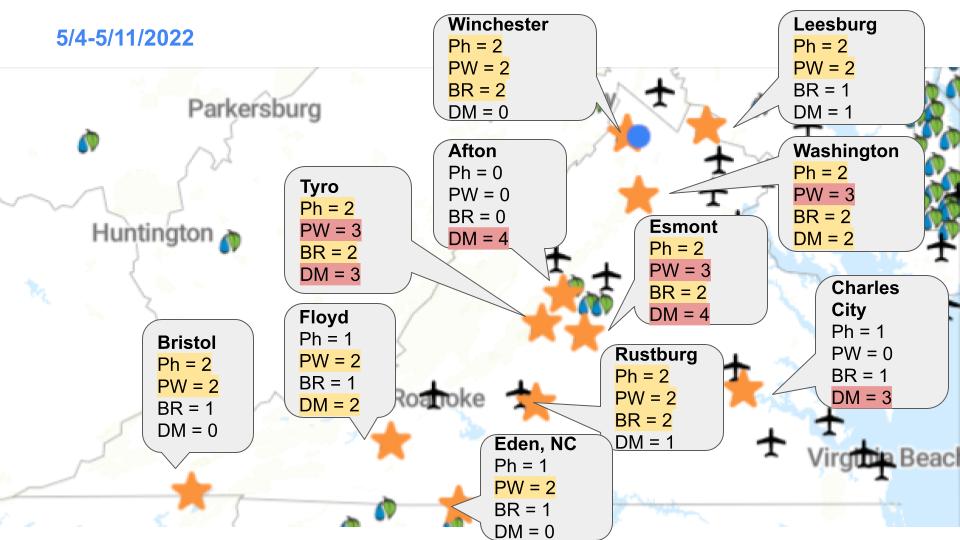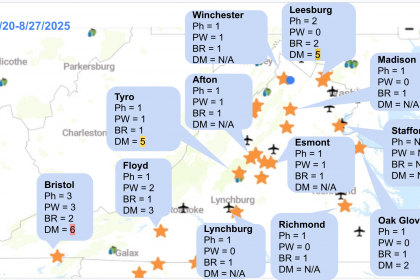Risk summary
As a part of a Wine Board-funded the Sentinel Vineyard project, we received NEWA weather stations that have been installed throughout the state. Here’s a snapshot from the last week, showing the number of days with the risk of each disease: Ph = Phomopsis, PW = Powdery mildew, BR = Black rot, and DM = Downy mildew.

Rains observed in the last 7 days resulted in several days with at least one downy mildew risk event (sometimes the NEWA model shows two risks in one day). It seems that locations in central VA had more warm rains than the rest of the state. Also, several days with powdery mildew risk were observed in the same area. Make sure to include a downy mildew material (Mancozeb or captan or fixed copper will do) and a powdery mildew material (sulfur or fixed copper is a good choice at this time of the season) in your spray materials.
Also, some cultivars in southern and central VA are probably getting close to bloom. I listed a few tips in the next section.
[NOTE: Our Cabernet Sauvignon is about to pass the time for Phomopsis protection spray (~1-3 inches shoot growth), thus, many locations in the southern and central VA are probably out of period to provide protection against Phomopsis.]
Reminder on Phomopsis spray. (just in case)
Reminder on early-season disease management (PowerPoint slide)
The image above is just a summary. Please visit https://newa.cornell.edu/ to obtain more detailed information. You can check daily weather data as well as disease and insect pest model results including forecasted risks. We paid the annual fee so that growers in Virginia can freely access NEWA. Please take advantage of the resources.
At bloom grape disease management
Bloom is the start of the critical time for cluster infections by downy mildew, powdery mildew, black rot, Botrytis, and ripe rot, because pathogens of these diseases can infect flower parts. Symptoms may develop soon after infection (e.g., downy and powdery mildew) or close to harvest (e.g., Botrytis and ripe rot).
What I recommend often is the use of protective materials to protect tissues for 4-6 weeks for V. vinifera varieties, and 3-4 weeks for V. labrusca varieties, which should translate into 3-4 sprays for V. vinifera, and 2-3 sprays for V. labrusca. If you have hybrids, they are somewhere in between, so, 4-5 weeks to be protected. As usual, please make sure to rotate mode of action (= FRAC) groups.
Below is a list of materials for each disease. Please consider your specific situations (site, cultivar, history of diseases, recent weather, weather forecast, etc., before making your decisions). In general, it is much easier and more efficient in terms of cost and also the environmental impact to protect your vines than trying to rescue diseased vines. Do not wait until you see diseases!
Powdery mildew: Sulfur (FRAC M2) is an economical option for powdery mildew prevention. Copper (FRAC M1) is also effective against powdery mildew, but I found the copper formulation I used was slightly less effective than sulfur. Other powdery mildew materials are: DMI fungicides (e.g., Rally, Elite, Mettle, Rhyme, Ceyva, etc, FRAC 3), Quintec (FRAC 13), Vivando (FRAC 50), Luna Experience (FRAC 7 + 3), Topguard EQ (FRAC 11 + 3), Aprovia (FRAC 7), Aprovia Top (FRAC 7 + 3), Miravis Prime (FRAC 7 + 12), Torino (FRAC U6), etc. Please make sure to rotate FRAC codes. Try to limit the use of a particular FRAC code to twice a season with an exception of ones that starts from M. Unfortunately, we have widespread QoI (FRAC 11, e.g., Abound, Flint, etc.) fungicide resistance powdery mildew isolates in VA, so, I would not count on the QoI material for powdery mildew management.
Downy mildew: Protective materials for downy mildew are: Mancozeb (FRAC M3) [Gavel has mancozeb + zoxamid (FRAC 22)], Captan (FRAC M4), Fixed copper (FRAC M1), Revus or Forum (FRAC 40), or Zampro (FRAC 40 + 45), or Ranman (FRAC 21)). NOTE: there are increasing cases of Revus resistant downy mildew isolates in VA. Plus, resistance to Ranman is known among downy mildew pathogens of other crops. Make sure to spray before the rain and rotate the FRAC codes!
Black rot: Protective materials for black rot are: Mancozeb, QoI (FRAC 11, Aboud, Flint, Pristine, Intuity, etc.), and DMI (FRAC 3, tebuconazole, Elite, Rally, Rhyme, etc). NOTE: Captan and copper won’t work against black rot. There is a concern about the fungicide resistance with FRAC 3 materials in NY. I have not seen the same trend in my vineyard, but if you feel your DMI material(s) does not provide good control of black rot, please contact me.
Kick-back materials for downy mildew and black rot: We have materials with kick-back activities against downy mildew (Ridomil products (FRAC 4), phosphite (FRAC P07, Prophyt, Phostrol, etc.), and black rot (myclobutanil (FRAC 3, DMI), etc.). They can be effective between infection and establishment of the pathogen (i.e., you should spray within 3-4 days after the rain). We do not have any eradicant that can kill already established pathogens. Infection on flowers and young fruits can happen very fast. Thus, rather than relying on the kick-back action, it is better to protect the vines.
Botrytis: The development of Botrytis depends on what type of varieties you grow, as well as your canopy management strategies. White-fruited varieties with tight cluster architecture tend to be more prone to Botrytis. I.e., a red-fruited variety with loose clusters probably has fewer issues with Botrytis, especially if the canopy is well maintained. Since Botrytis pathogen likes high humidity, a poorly managed canopy that traps humidity will help them to thrive.
Bloom time is important for Botrytis management because this fungus can infect flower and flower debris, and symptoms develop later when berries are maturing. There is a number of Botrytis materials such as Rovral and Meteor (FRAC 2), Elevate (FRAC 17), Vanguard and Scala (FRAC 9), Luna Experience (FRAC 7+3), Kenja (FRAC 7), Miravis Prime (FRAC 7 + 12) Switch (FRAC 9 + 12), etc. As with powdery mildew, QoI fungicides are no longer the best material for us due to the development of QoI-resistant Botrytis isolates throughout VA.
Ripe rot: Mancozeb, ziram (FRAC M3), captan (FRAC M4), and QoI (Strobilurin, FRAC 11) fungicides are currently recommended. But due to the 66-day PHI of mancozeb, you may not have enough days remaining to spray mancozeb later in the season. Based on our lab and field tests, mancozeb, captan, copper (FRAC M1), tebuconazole (FRAC 3), azoxystrobin (FRAC 11), and Switch (FRAC 9 + 12) provided some level of efficacy against ripe rot pathogens; however, none of the products provided sufficient degree of control by itself. Also, some of the isolates causing ripe rot are not sensitive to some of those materials. Thus, when it comes to ripe rot management, please think of not only a rotation of modes of action, but also a tank mix of at least two modes of action. The timing of the application will be similar to that of Botrytis: bloom, bunch closure, and veraison. If you have cultivars that will be left on vines for an extended period after veraison, it is probably a good idea to apply one more spray two weeks after veraison.
Last, but not least, we will have our monthly viticulture meeting next Thursday (the 19th) from 1 PM.
That’s it for today. See you at the VVA meeting!!






This Post Has 2 Comments